This website is supported by its readers. If you click one of my links I may earn a commission. I am also a participant in the Amazon affiliates program and I will also earn a commission from qualified purchases.
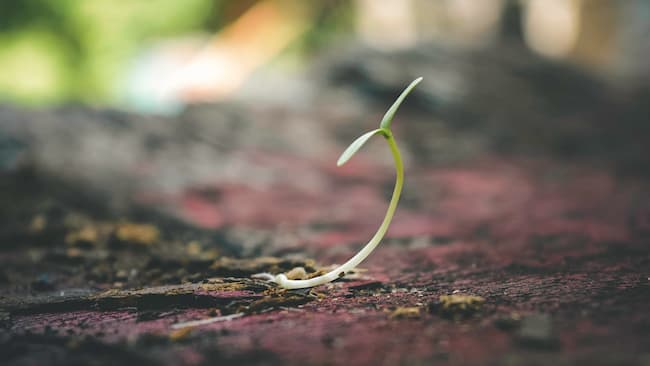
Oak trees are one of the world’s most sturdy and resilient plants. However, it can take an incredibly long time for the tree to mature. So, how long do oak saplings take to grow?
An oak sapling can take anywhere from four to seven years to take root fully. After that, it needs an additional 10 or 20 years to mature and sprout acorns. Depending on the type of oak, it may even take longer before you see your first acorn.
Let’s dive into the growing patterns of oak and answer How Long Do Oak Saplings Take to Grow in more detail.
Just a quick heads up, over the past three years of running Plantpaladin, hundreds of people have asked for product recommendations. As such, You can find my favorite indoor bonsai tree here (link takes you to Bonsaiboy), my favorite outdoor bonsai tree (link takes you to Bonsaiboy), or have a look at all the products I recommend here.
How long do oak saplings take to grow?
If you’ve seen oak trees in person, you know how massive they can be. There are hundreds of different species, and some of them can grow to over 100 feet tall!
These plants belong to the Fagaceae family, which includes trees like beeches. They’ve been around for a long time and show no signs of slowing down.
Even though oak trees can grow large, it doesn’t happen overnight. Usually, it can take decades for the plants to mature.
As such, I was thinking about growing my oak tree from an acorn, so I got in touch with my local botanical gardens and asked ten plant paladin readers their thoughts on how long oak saplings take to grow.
So How Long Do Oak Saplings Take to Grow?
To summarize:
- Oak trees will typically take four to seven years to take root fully.
- At this stage, oak trees will not grow super tall but instead spend most of their time growing foundation, absorbing as many nutrients from the soil as possible, giving the tree enough energy to shoot up overall.
- Oak trees will typically start germinating after 1 to 3 weeks.
- After six months, oak trees will start to form into a seedling.
- The sapling stage of oak trees will take about one to 5 years to grow.
- Most oak trees will reach maturity, regardless of species, in about eight years and reach the complete adult stage in about 10 to 20 years.
- Once fully grown, oak trees typically grow about one additional foot per year.
- Following this, oak trees will average
So, let’s take a glance at the life stages to expect here:
Stage | Length |
Germination | 1–3 weeks |
Seedling | 6 months |
Sapling | 1–5 years |
Maturation | 6–9 years |
Adult | 10+ years |
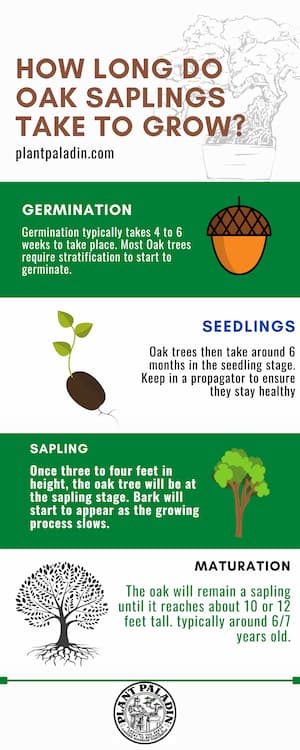
Germination
The first stage an oak sapling will go through is germination. Just like most plants, oak trees start as seeds/acorns.
When you place a seed in a moist environment, it activates, but it’ll also require a few conditions before it grows, including.
- Warmth
- Light
- Oxygen
Along with water, these elements will cause the seeds/acorns’ hard outer shells to break down. At this point, the plant will have room to branch out and grow.
First, tiny roots will begin to sprout from the acorn. These will be responsible for absorbing water and other minerals.
After a while, a shoot will break out from the top. This part will start growing up, towards the sun, to gather light for energy.
Depending on the growing conditions, this stage can take a few weeks.
Seedling
The shoot will eventually become a stem that can support itself and stand upright. As soon as the stem breaks out of the soil into the air, we call it a seedling.
At this stage, the plant is at its most fragile. That’s because it no longer has the protection of the hard shell, leaving behind a fleshy, soft structure.
This is also when the seedling will need extra nutrients. Primarily, it’ll need plenty of nitrogen to continue growing.
As time goes on, the stem and roots will develop and increase in size. The roots will dig deeper into the ground and anchor the plant in the soil.
During this time, the stems will keep growing up in the direction of the sun.
Consider growing the seedling in a propagator during this delicate stage to allow you to become in control of all aspects of the tree.
Sapling
Once the stem reaches about three or four feet, the plant is a sapling.
It’s slightly more robust than seedlings, but it still needs shielding. After all, many small animals like to nibble on tiny saplings!
This stage is slow so you won’t notice any changes immediately. However, with some time, the stem should start branching out and creating small shoots.
Before the tree can move to the next stage, the stem needs to harden. So, its exterior needs to be able to support further upwards growth.
That’s when some bark will appear. The rigid shell will protect the plant and slow down the growing process. For that reason, it can take several years for this stage to end.
Maturation
The oak will remain a sapling until it reaches about 10 or 12 feet tall. During this part, the tree will grow branches, leaves, and sturdier roots.
After that, the tree will start to mature, which means it should be able to grow fruit. By the time the plant is six or seven years old, you might spot the first acorn.
The rate of fruiting will gradually increase until the oak reaches full maturity.
Adult
Right after the 10-year marker, we can consider the oak tree an adult. It should be able to sustain itself and fruit with no intervention.
The plant will continue to grow upwards, and its bark will get thicker over time.
Then, the oak will stay in this state for hundreds of years or until someone cuts it down, which would be a severe shame!
How Long Oak Saplings Will Take to Start Sprouting
The process can take up to four or five years, a bit longer than the first sprouting in the oak’s life cycle.
If you recall, the first instance of this happens between the seedling and the sapling stages.
The shoot will burst out of the shell and snake its way out of the soil. This phase is when the stem sprout out, which can take six months to a year.
Next, the second sprouting occurs in the middle of the sapling stage. The main stem will shoot out a couple of new branches.
How Fast Do Oak Trees/Saplings Take to Grow Compared to Other Tree Species/Saplings?
Even though the growth rate of oak trees seems slow, it’s relatively average. Most trees need anywhere from 10 to 40 years to fully mature.
For comparison, pine trees can take about 25 to 30 years before they reach full height. On the other hand, apple trees will only require about five or six years to fruit.
How Long Do Different Oak Species Take to Grow Compared to Each Other?
The growth rate will also change depending on the oak tree species.
Species | Growth Rate/Year | Average Lifespan |
Red Oak | 24–26 inches | 400 years |
Southern Red Oak | 12–30 inches | 275 years |
Valley Oak | 24–35 inches | 600 years |
Willow Oak | 13–24 inches | 100 years |
Japanese Evergreen Oak | 36–40 inches | Over 1,000 years |
How to Speed up the Growth of an Oak Tree/Sapling
Growing oaks requires patience. Still, it’s only normal to want to speed up the process a bit.
Oak trees rely on the surrounding resources to grow. So, with more nutrients and water, the plants should be able to develop at maximum speed.
There are a few major factors that will have a significant effect on the growth rate.
Adjust the Watering Schedule
As we all know, all plants need some water content to survive, but this is even more true for growing saplings. They need a constant supply to support the ongoing development.
Usually, a sapling will need watering every couple of weeks. Otherwise, you’ll stunt or even compromise the growth rate.
As the tree matures, it gets more drought-tolerant.
Find the Right Location
Most mature oak trees are enormous and need plenty of space, both above and underground. The roots need to be able to spread out to anchor the trees.
Ideally, each tree needs around 10 to 20 feet of clear space in all directions.
If they don’t have room, the roots can contort and twist over each other. When that happens, water and nutrients can’t move freely to the plant.
In that case, the oak won’t be able to grow new structures quickly.
Watch Out for Environmental Conditions
The weather conditions around your trees can also affect the growth rate.
Generally, oaks thrive in a mild temperature of about 50℉ or more. On top of that, they need full sunlight to sustain the growth cycle.
Both the temperature and sun need to remain somewhat constant for healthy development. That means the plants will mature faster in tropical climates or USDA zones 7–10.

Check the Soil Characteristics
Over time, the concentration of valuable elements in the ground decreases, which can bring the development rate to a halt.
Adding some fertilizer should ensure the trees have what they need when that happens. The best type for oak trees is a 12:4:8, which is a ratio between nitrogen, phosphorus, and potassium, respectively.
It’s also a good idea to check the soil pH since oaks prefer an acidic environment, around 3.6–7.
However, even with perfect conditions, you can’t guarantee fast development. The tree will take its time and mature at its own pace, and you can only try to give it the best care possible! You still need to gain control over the growth rate.
How to Plant an Oak Sapling (Or Seed)
Growing an oak tree isn’t quick, but it’s pretty straightforward.
Thankfully I’ve written a post that goes into more detail on how to grow an oak tree from an acorn here.
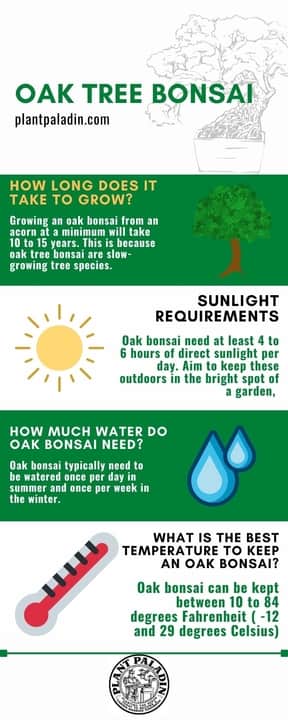
However, let’s look at the steps you can follow to plant an oak sapling or an acorn.
There are large varieties and smaller options depending on your preferences.
You can even grow an oak bonsai tree!
Most of the time, people choose to grow oak trees from seeds over saplings. However, if you have a sapling on your hand ready for planting, you can skip the seedling steps.
Start the Seedling Process
You might think planting a seed/acorn is as easy as placing it in some soil and adding water. However, that’s not the case.
Some seeds require a starting process (stratification) before they can grow. For oak trees, this stage usually involves cold storage.
Placing the seed/acorn in a sealed bag with a small amount of water would be best. Sphagnum moss can also be used.
Then, the entire bag goes into freezing conditions.

Typically, the ideal temperature is between 20 and 40℉. After a while, the seed will sprout and be ready for planting.
Here are some examples:
Seedling Species | Starting Process | Duration |
Red Oak | Cold germination | 45–60 days |
Southern Red Oak | Cold germination | 45–60 days |
Valley Oak | Cold, wet germination | 90 days |
Willow Oak | None | 20–60 days |
Japanese Evergreen Oak | Cold storage | 30 days |
Remember that these numbers can change slightly depending on where you live.
Get the Right Container
Now that the seeds have sprouted, it’s time to plant them in the soil. To do that, you’ll need a deep container. Anywhere between 10 and 12 inches should do the trick.
Make sure that there’s proper draining in the pot. Drill a few holes at the bottom using a regular container. This trick will allow excess water to escape to avoid root rot.
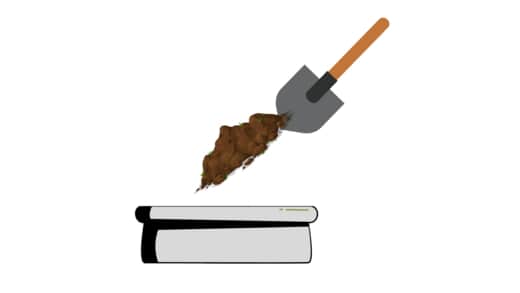
Plant the Seedling/acorn
Fill up the vessel with high-quality soil. You can make your mix using loam and sand, but the store-bought variety should work fine.
After that, you can moisten all the soil, but be careful not to over-water it. All you need is for it to be a little damp and shiny.
Use your finger to dig a hole about one or two inches into the soil, then place the seedling in the hole and cover it. When planting more than one seed, try to space them out. For the best results, only place one seedling per container.
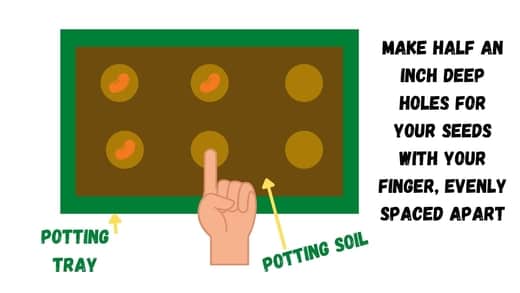
If you have a deep tray, consider planting multiple seedlings, as this will give you a better chance of growing an oak tree.
Since the plant is incredibly fragile, be as gentle as possible. If any of the roots or other structures break, the seedling may not grow at all!
Maintain the Seedling With Watering and Aeration
After placing the seedling in the soil, it’ll look like nothing is happening for a while. Yet, you still need to care for your plant. This maintenance will mostly be in the form of regular watering.
It can take a lot of work to figure out exactly when to add water so that you can use the finger test. Poke your fingers about two to three inches into the soil. If it feels dry and crumbly, it’s time for more water.

During this period, it’s also a good idea to aerate the soil. That means adding air and oxygen to the mix.
To do that, use a chopstick or another thin and long object. Gently press the chopstick down to the bottom of the pot. Do that all around the soil, avoiding the plant itself.
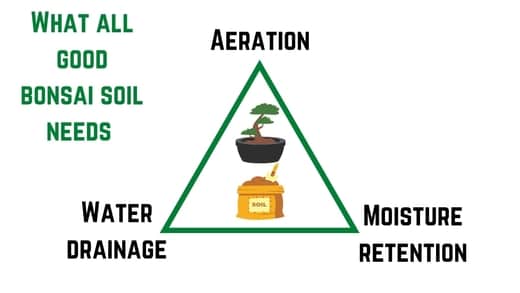
Keep up this process until you start to see your sapling change. Eventually, you should see a stem peeking out from the soil.
Transplant the Viable Sapling
You’ll want to repot the plant as soon as the stem pokes out of the soil to stop it from forming a complex web of roots. If you wait too long, you may have to damage the plant to get it out. So, when you see the stem growing, you can move the plant from the pot to its final location.
Begin by slowly removing excess soil. The easiest way to do this is using a garden shovel to remove small amounts of soil at a time from the pot. Just resist the urge to tip over the container to pour it out. It’s faster, but you risk damaging the fragile plant.
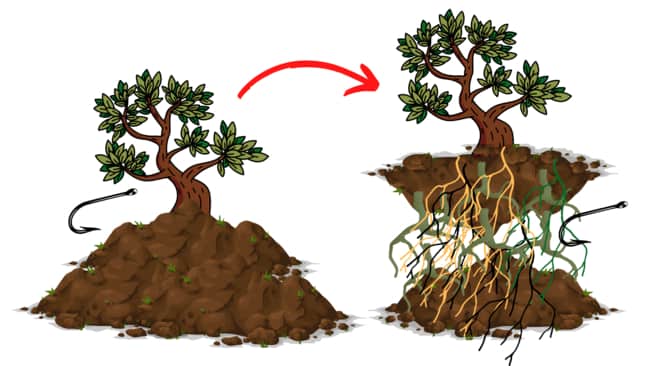
After you expose most of the sapling, try picking it up with your hands. If it’s too delicate, you may need tweezers.
Using your hands, dig a couple of inches into the ground and create a small nest for the sapling. Next, cover the plant with soil, ensuring the stem is above ground; burying the shoot will stop the plant from growing! Then, carry the whole thing to the new planting area.
Finally, add a little water to the area and pat down the soil around the oak sapling.
When to Collect the Acorns and When to Plant Them?
Another way to spend up on How Long Do Oak Saplings Take to Grow is by using natural acorns.
You’ll need acorns if you prefer the traditional way of growing the oak tree over saplings. So, start by choosing a tree with a healthy fruit supply.
It’s best to select a large tree because they usually have more developed acorns. This will give you a better chance at successfully germinating the plant.
When doing this, don’t pick the acorns off the tree. Instead, wait for them to fall, which means they’ve ripened naturally.
Like most other plants, the fruit drops off the tree in fall. Usually, this will begin around September. Still, waiting until mid-October will increase the chances of finding a viable acorn.
Choosing the Best Acorns
Picking out the best acorn is a little tricky. Most will look the same, so it cannot be easy to distinguish between them.
Keep in mind that not all acorns can grow into trees. That’s why it’s a good idea to gather a few in case the one you plant doesn’t sprout.
However, there are a few key markers that you should keep an eye out for.
Color
The first indication of a ripe acorn is its color. When the fruit first grows, it has a bright, light green shade. As it matures, the color will darken and slowly turn brown.
Ideally, you want to find an acorn somewhere in the middle. Look for fruit with a dark exterior and a few green streaks.
If you only have a limited selection of acorns, go for ones with visible green patches. They won’t be ready to plant, but you can always let them mature.
Avoid solid brown acorns since there’s a higher chance they may have completely dried out.
Cap
When you look at an acorn, you can see it’s divided into two sections. The nut makes up most of the main structure and has a cap.
You have to remove this cover to decide if the fruit is viable. Then, take a sharp knife and coax it between the nut and the cap.
Then, gently twist the knife and pop the cap off. Be careful not to damage the nut portion, or it may dry out before you even plant it!
Once the cover is off, inspect the scar, it leaves behind. This area has to be relatively light, almost a pale tan shade. It should also be firm and rough to the touch.
The acorn isn’t mature enough to plant if the area is green or soft.
Outer Shell
Finally, look at the protective layer outside of the acorn. Check for any scratches on the surface.
With deep scrapes on the surface, the fruit may rot as soon as you place it in the ground. This is because water will seep inside the acorn instead of slowly breaking down the shell.
Next, keep an eye out for any holes or other markings. This could mean that an insect, like weevil grubs, has found its way to the center of the fruit.
When that happens, the pest will feed on the acorn, and there will be nothing left to plant.
Finally, identify any mushy or dark brown spots. Seeing those could mean that the acorn has an infection.
Weight
The final characteristic to look out for is weight. Unfortunately, it’s almost impossible to tell the exact mass of an acorn by looking at it.
You can tell that some of them are larger than others, but that doesn’t always mean they’re heavier. What you want here is a fruit that weighs around 4–10 grams. Now, before you break out your scale, there’s an easier way to figure this out.
Grab a large bowl about 10 inches deep and fill it with water to the brim. Then, carefully place each acorn on the surface.
The water will test whether the acorn is hollow or not. You need this information because empty shells can’t grow healthy trees.

So, if the fruit sinks, it’s ready to plant. If you see it floating, it means it isn’t viable.
When to Plant Acorns for Best Results
The best time to grow an oak tree is around mid-fall. So, as soon as you pick up the acorn in October, it’s a good idea to plant it simultaneously.
Still, if you can’t get to it right away, you can always wait until the beginning of spring.
How Long Do Oak Trees Live In Total?
On average, oak trees can live anywhere from 100 to 400 years. However, this will depend on the environment and the plant species. Some trees manage to live for thousands of years. Pechanga great oak is the oldest oak in the world, over 2,000 years old!
Survey results
I also asked ten plant paladin readers how long their oak saplings take to grow.
Here are the results:
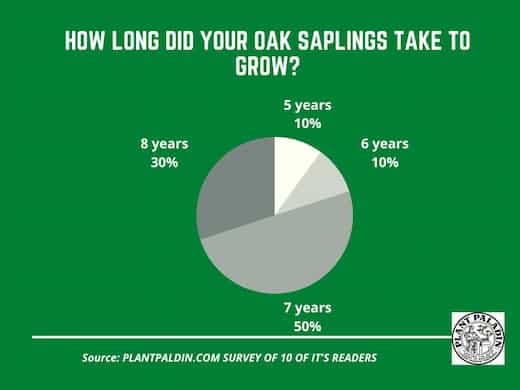
Wrapping Up
So, how long do oak saplings take to grow?
Generally, it’ll take four to seven years for a sapling to grow. However, it’ll need ten or more years to fully mature. A few factors can affect this duration, from the watering schedule to the planting location.
Still, environmental conditions and soil characteristics also play a significant role.
Finally, you can grow an oak tree from a sapling or an acorn. If you go the fruit route, check the nut’s integrity before planting it.
My top picks for the gear you will need!
So like I mentioned earlier, over the past three years of running PlantPaladin, hundreds of people have asked me for my recommendations on the best bonsai gear on the market.
Having spent thousands of dollars on bonsai items these past few years and tested at least 100 bonsai-specific products, I’ve listed my favorite products below – All of which I highly recommend and think you can get great value.
They can purchase directly by clicking the link to take them to Amazon.
Bonsai Tool Set: One of the significant challenges I’ve had is finding a toolset that was not only durable but didn’t break the bank. SOLIGT has recently developed a fantastic bonsai tool set that covers all the tools you need to trim, prune, and repot your trees. – You can grab it here.
Complete Bonsai Set: Many of you will want to grow your bonsai trees entirely from scratch, but finding the varicose seeds, pots, and other items in one place can be challenging. Leaves and Sole then have created a complete bonsai set that I’ve personally used that ticks all the boxes. You can grab it here.
Bonsai wire: The number of times I’ve run out of wire for my bonsai or purchased cheap bonsai wire that doesn’t do the job is embarrassing for me to admit. After a lot of trial and error, I found that using Hotop’s aluminum bonsai wire is one of the best options on the market. This can easily be used for both indoor and outdoor bonsai. You can grab it here.
This post was written by Fehed Nicass who has been passionate about bonsai for over 3 years.
